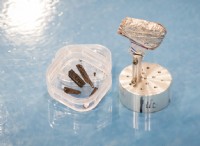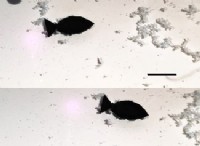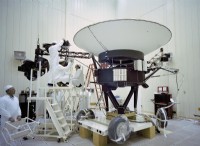모두가 매듭이 무엇인지 알고 있습니다. 그러나 매듭은 수학과 과학에 특별한 의미가 있습니다. 그들의 속성은 DNA의 생화학, 새로운 재료의 합성 및 3 차원 공간의 기하학만큼 광범위한 주제 내에 숨겨진 비밀을 잠금 해제 할 수 있기 때문입니다. 이 에피소드에서 주인 Steven Strogatz는 동료 수학자 Colin Adams와 Lisa Piccirillo와 함께 매듭의 신비를 탐구합니다.
Apple Podcasts, Spotify, Google Podcasts, Stitcher, Tunein 또는 좋아하는 팟 캐스팅 앱에서 듣거나 Quanta 에서 스트리밍 할 수 있습니다. .
전사
Steven Strogatz (0:03) :저는 Steve Strogatz입니다. 이것이 왜 의 기쁨입니다. , Quanta Magazine 의 팟 캐스트 그것은 오늘날 과학과 수학에서 가장 큰 답변이없는 질문으로 당신을 안내합니다. 이 에피소드에서는 매듭에 대해 이야기 할 것입니다.
우리는 모두 매듭이 무엇인지 알고 있습니까? 그것들은 당신이 당신의 신발에 묶는 매듭 또는 수하물을 차 상단에 고정시키는 데 사용하는 종류입니다. 두 개의 자유 끝이있는 끈을 가지고 매듭을 묶는다면, 그런 종류의 매듭은 취소 될 수 있습니다. 때로는 자유 끝이 느슨해지고 매듭이 풀리게됩니다. 그러나 끝을 함께 융합 시키면 일종의 접착제를 함께 붙이면 매듭이 고리에 갇히게됩니다. 그런 다음 질문이됩니다. 어떻게 든 루프를 자르지 않고 루프에서 그 매듭을 제거 할 수 있습니까?
가능하다면, 그것은 전혀 매듭이 아닙니다. 그것은 단지 원일 뿐이며 단순한 루프와 동등한 것, 또는 수학자들이“사소한 매듭”으로 기각하는 것입니다. 그러나 당신이 그것을 취소 할 수 없다면, 그것은 얽힌 루프를 얼마나 멀리 단순화 할 수 있습니까?
와 같은 모든 종류의 질문을 제기합니다.수학자들은 다른 유형의 매듭을 어떻게 구별합니까? 얼마나 많은 종류의 매듭이 있습니까? 어쨌든 수학자와 과학자들은 왜 매듭에 관심을 갖습니까? 이 수학 분야에 대한 실제 응용 프로그램은 이제 매듭 이론이라고 불립니다. 그것은 약 150 년 전 화학 요소의 신비로 시작되었는데, 당시에는 에테르에 묶인 다른 종류의 매듭으로 생각되었습니다. 오늘날, 매듭 이론은 효소가 연결된 DNA의 가닥을 어떻게 풀릴 수 있는지 이해하는 데 도움이됩니다. 또한 매듭 이론은 일부 화학 요법 약물을 포함하여 새로운 종류의 의약품을 만들기위한 기본 연구에서 잠재력을 가지고 있습니다. 그러나 수학 자체에서 매듭 이론은 수학자들이 고차원 공간의 수수께끼를 해결하도록 돕고 있습니다.
노트 주변의 미스터리를 풀기 위해 지금 저와 함께하는 것은 Colin Adams입니다. 그는 Williams College의 Thomas T. Reed 수학 교수이며, Journal of Knot Theory and Its Famifications 의 관리 편집자 중 하나입니다. . Adams는 또한 만화책 왜 매듭? 을 썼습니다 나중에 우리는 Lisa Piccirillo와 대화 할 것입니다. 그녀는 MIT의 수학 조교수이며 최근 Conway Knot이라는 매듭에 대한 오랜 수학 퍼즐을 해결했습니다. 콜린 아담스, 오늘 우리와 함께 해주셔서 감사합니다.
콜린 아담스 (2:35) :오, 여기에있는 것이 정말 재미 있습니다. 나를 초대해 주셔서 대단히 감사합니다.
strogatz (2:38) :글쎄, 그것은 저에게 진정한 대접입니다. 콜린, 나는 당신의 작품의 열렬한 팬입니다. 나는 매듭에 관한 당신의 책을 좋아합니다. 나는 그들로부터 많은 것을 배웠습니다. 그래서 좋아, 나는 매듭과 매듭 이론에 대한 간단한 소개를하려고 노력했지만, 당신이 그들에 대해 들어 본 적이 없거나 신발 끈을 묶는 것에 대해 생각하지 않은 사람에게 어떻게 설명 할 것인지 듣고 싶습니다.
.adams (2:55) :예, 내 말은, 수학 분야 의이 분야에있는 큰 장점 중 하나입니다. 일반적으로 비행기에 누군가 옆에 앉아“무엇을합니까?”라고 말하면 알다시피. 그리고 당신은 수학자이고, 당신이하는 일을 그들에게 설명하는 데 어려움을 겪을 것입니다. 그러나 나는 신발 끈을 가져갈 수 있다는 큰 이점이 있고, 신발을 벗을 수 있고, 그것을 끌어 올릴 수 있습니다. 나는이 신발 끈에 매듭을 묶은 다음 두 개의 느슨한 끝을 함께 붙일 수 있으며 그 물체를 연구하려고 노력할 수 있습니다. 아니면 그렇지 않습니까? 절단하지 않고 풀릴 수 있습니까?
그리고 이것은 매우 어려운 문제입니다. 내 말은, 당신은 당신이 가지고있는 것을 상상할 수 있습니다. 어떤 사람은 당신에게 두 개의 느슨한 끝이 함께 붙어있는 두 개의 느슨한 끝이 얽힌 끈의 엉망진창을 제공합니다. 그리고 그들은 당신에게 질문을합니다. 당신은 그것을 풀릴 수 있습니까? 그리고 당신은 다음 6 년 동안 그것을 풀려고 노력합니다. 그리고 6 년 후, 당신은 성공하지 못했습니다. 그러나 당신은 여전히 5 분의 작업이 트릭을 할 수 있다는 것을 여전히 모릅니다. 따라서 성공 여부를 결정할 수있는 몇 가지 기술, 몇 가지 수학 기술을 갖는 것을 좋아합니다.
strogatz (3:28) :그래서, 매듭은 우리 주위에 있습니다. 그들이 현실 세계에서 팝업되는 다른 예를 알려줄 수 있습니까?
adams (4:00) :예, 매듭은 오랫동안 주변에있었습니다. 실제 유용성 측면에서, 과학 측면에서, 당신이 준 한 가지 예는 정말 좋은 예입니다. DNA가 세포의 핵 내부에있는 DNA의 예입니다. 그리고 그것은 모두 거기에 포장되어 있습니다. 사람들은 농구에 100km의 낚시 선을 넣는 것으로 묘사했습니다. 그래서 그것은 거기 에서이 큰 엉망입니다. 그럼에도 불구하고, 그것은 전사, 재조합을 수행 할 수 있어야한다. 그것은 그 자체로 사본을 만들 수 있어야합니다. 그러면 그 자체로 분리 될 수 있습니다. 그리고 당신이 언급했듯이, 이들 효소는 세포의 핵 내부의이 효소를 필요로한다는 것은 효소가 두 가닥의 DNA를 가져 가고, 다른 하나를 옆으로 당기고, 하나를 열고, 다른 하나를 밀고, 다시 닫아 교차 변화의 매듭 이론을 만듭니다. 그리고 이것은이 효소가 실제로 DNA에 그렇게하고 있다는 항상 우리 안에서 진행되고 있습니다. 그리고 효소가 그렇게하는 것을 막으면 DNA가 스스로 재현하지 못하게 할 수 있습니다. 이것이 실제로 이것이 화학 요법에 사용되는 이유입니다. 효소가 DNA에 작용하고 매듭과 매듭을 변화시키는 것을 방지하는 이러한 화학 요법 약물이 있습니다. 이것이 DNA에 매듭이 어떻게 나타나는지의 예입니다.
내가 매우 흥미로운 것으로 생각되는 또 다른 예는 합성 화학을위한 것입니다. 따라서 합성 화학에서는 새로운 분자를 합성하려고합니다. 그리고 당신이 모두 함께 결합 된 원자 세트로 구성된 분자를 가지고 있다고 상상해보십시오. 그리고 그것은 실제로 분자 수준에있는 사소한 매듭의 예일 것입니다. 이제 사소한 매듭을 가져다가 열린 곳을 자르고 분자 수준에 매듭을 묶은 다음 두 개의 느슨한 끝을 함께 붙입니다. 그리고 일단 당신이 그렇게하면, 당신은 동일한 구성 원자가 정확히 같은 순서로 결합되어 있습니다. 이제 만 지금 당신은 새로운 물질, 매듭이있는 물질을 가지고있는 반면, 이전의 물질은 노트에 없어졌습니다.
그래서 당신이 가질 수있는 각 종류의 매듭에 대해-무제한 숫자가 있지만, 작은 교차 수, 수백만, 수백만의 경우에도 각 매듭은 이제 새로운 물질이 될 수 있습니다. 따라서 합성 화학자들은이 아이디어에 대해 만 침을 흘리고 있습니다. 그리고 그들은 분자 수준에서 매듭을 짓는 방법을 생각해 내기 위해 열심히 노력하고 있습니다.
strogatz (6:09) :그것은 내가 학부생이라는 것을 상기시켜줍니다. 나는 부모님이 나에게 열을 전하기 위해 유기농 화학 과정을 수강하고있었습니다. 그래서 나는 다른 모든 프리 메드와 마찬가지로 Orgo [유기 화학]을 복용하고 있었고, 수학을 좋아하는 사람으로서 우리 교수가 당신이 묘사 한 것에 대해 이야기 한 것에 대해 정말 매료 된 것을 기억합니다. 그러나 그 당시에는 단지 가설이었다. 그들은 당시 합성 적으로 분자를 매듭이나 연결하는 방법을 몰랐지만 생각하는 것이 흥미 롭다고 말했습니다. 당신이 말하는 것처럼, 당신은 알다시피, 아시다시피 - 수소와 탄소가있는 중합체가 될 수 있으며, 이전과 동일한 이웃을 가진 동일한 배열로 정확히 같은 원자를 보관할 수 있습니다. 그러나 당신은 매듭이 묶여 있었기 때문에 토폴로지 이성질체 인 이성질체를 만들 수 있습니다. 그러나 당신은 다른 화학적 특성을 가질 것인지 알 수 있습니까?
adams (6:58) :예, 그리고 기대는 일반적으로 대답은 다른 속성을 가져야한다는 것입니다. 그리고 당신은 기름처럼 행동하는 것을 가질 수 있고 다른 하나는 완전히 다르게 행동하고 있습니다. 그래서 - 흥미 롭습니다. 해군은 실제로 이것에 대한 많은 연구에 자금을 지원했으며, 레이더를 피하기 위해 잠수함과 함께 잠수함을 코팅 할 수있는 새로운 물질을 내놓는 데 매우 관심이 있었기 때문에 실제로 시작되었습니다. 그래서 많은 돈이 나온 곳은 흥미 롭습니다.
strogatz (7:22) :농담 없음.
Adams : 이것을 연구하기 위해, 그래.
strogatz : 일종의 스텔스 기술처럼.
Adams : 그래.
strogatz (7:27) :와우, 스텔스 봉사의 토폴로지. 허, 나는 그것에 대해 들어 본 적이 없었다. 멋지다.
우리는 왜 화학이나 군대와 같은 분야의 사람들이나 화학 요법 약물을 사용하는 의사들이 이러한 종류의 매듭 문제에 관심이 있는지보기 시작했습니다. 그러나 왜 그들은 수학적으로 그렇게 흥미로운가?
adams (7:46) :매듭 이론은 토폴로지의 더 넓은 분야의 하위 필드이며, 토폴로지는이 물체가 고무로 만든 것처럼 대상을 처리하는 수학 영역입니다. 예를 들어, 6 개의 모서리를 꺼내고 절단이나 붙여 넣지 않고 구체를 큐브로 변형시킬 수 있기 때문에 큐브와 동등한 구체를 가질 수 있습니다. 그리고 당신은 도넛, 도넛의 표면, 토러스에 해당하는 도넛을 고려합니다. 유명한 예는 커피 컵의 표면을 변형시키고 바닥에서 밀어 올릴 수 있고 도넛 표면처럼 보일 때까지 변형 할 수 있기 때문에 커피 컵과 동일합니다. 그래서 그것들은 같은 것으로 간주됩니다.
그래서 토폴로지는이 매우 넓은 수학 영역입니다. 매듭 이론은 실제로 그 하위 필드입니다. 다시 한 번, 우리는이 매듭을 우주에 앉아있는 것으로 취급하고 있지만 실제로 고무 매듭 인 것처럼 취급되어 변형 할 수 있습니다. 매듭 이론에 대한 질문을 이해할 때 실제로는 토폴로지에 관한 질문에 일반화 될 수있는 특정 질문입니다.
strogatz (8:50) :그래서 이것은 정말 흥미로운 차이, 당신이 만드는 중요한 차이점,이 아이디어 - 수학자들이 생각하고 싶어하는 매듭은 우리가 원하는만큼 비틀고 구부러지고 변형 될 수있는 이런 종류의 이상적인 고무적인 특성입니다. 그리고 실제로, 당신은 사람들이 매듭에 대해 생각할 때 현실 세계와 마찬가지로, 당신의 신발에 매듭을 말할 때 알다시피. 실제 매듭과 마찬가지로 수학자들이 무시하는 경향이있는 다른 측면이 있습니다. 그래서 당신은 수학자로서 매듭에 대해 생각할 때 벗어날 모든 것을 우리에게 말해야할까요?
adams (9:24) :예, 아니, 좋은 질문입니다. 예, 매듭은 수학자로 생각할 때 재미 있습니다. 예를 들어, 당신이 생각하고있는 것 중 하나, 매듭이 무한히 얇다 고 생각한다면, 매듭으로 자르고 묶인 원으로 생각하고 있습니다. 그러나 그 원의 두께는 한 지점의 두께를 가지고 있습니다. 매듭 이론을 고려할 때 실제로 고려해야 할 매우 마른 얇은 것입니다. 그리고 앞서 말했듯이, 당신은 그것을 열어서 매듭을 묶고 끝을 함께 붙일 것입니다. 그런 다음 원하는 방식으로 변형 할 수는 있지만 언제든지 스스로를 통과 할 수는 없습니다. 이것이 우리가 사용하는 규칙 중 하나입니다.
우리는 덜 분명한 다른 규칙이 있습니다. 마찬가지로, 매듭을 묶은 다음 끈을 묶을 때까지 줄이면서도 작아지고 작아 질 수 없을 때까지 끈으로 묶을 때까지 작은 매듭을 얻을 수 있습니다. 매듭 이론에서는 그렇게 할 수 없습니다. 그리고 당신이 피하는 방법 중 하나는 당신이 그것을 부분적으로 선형 선형이라고하는 것에 대해 이야기하는 것입니다. 따라서 모든 매듭이 실제로 매듭을 만들기 위해 끝까지 끝까지 끝까지 끝이있는 작은 막대기로 만들어졌으며, 경계가없는 스틱 수를 늘릴 수 없으므로 스틱 수를 항상 유한 수로 유지해야합니다. 그리고 그것은 당신의 매듭이있는 원 안에 더 작고 작은 매듭을 갖는이 문제를 피합니다. 그래서 그것들은 수학적으로 그들에 대해 이야기하기 위해 매듭을 입어야하는 몇 가지 조건입니다.
strogatz (10:44) :매듭 이론을 연구하여 어떤 종류의 수학을 배우고 있습니까? 그래서 내가 여기서 찾고있는 것은 공간이나 대수에 대해 무엇을 말하고 있습니까? 또는, 당신은 알다시피 - 매듭 이론에 대해 생각함으로써 수학 내의 연결은 무엇입니까?
adams (11:00) :누군가가 매듭 이론에서 물어볼 수있는 가장 기본적인 질문은 다음과 같습니다. 이것이 사소한 매듭입니까? 그래서 당신은 매듭이 사소한 매듭인지 아닌지를 말하고 싶습니다.
더 일반적으로 누군가 두 마리의 매듭을 건네줍니다. 그리고 당신은 말할 수 있기를 원합니다. 그들은 같은 매듭입니까? 그들은 같은 매듭입니까, 아니면 다른 매듭입니까? 그리고 이것은 다시 기본적인 질문 중 하나입니다. 1880 년대 이래로 사람들이 작업 한 문제 중 하나는 모든 매듭의 표로 모든 매듭의 테이블을 어느 정도 복잡하게 만들려고 노력하는 것입니다. 매듭 테이블에서, 우리는 교차로 수를 추적하고 특정 교차 수의 교차로가있는 매듭의 수를 결정하려고 시도하여이를 표로 표로 작성합니다.
.그리고 교차로에 의해 나는 당신이 당신의 매듭 사진을 찍고 그 그림을 보면, 매듭이 그 자체로 넘어가는 곳이있을 것임을 의미합니다. 그리고 우리는 우리가 교차로라고 부르는 곳입니다. 그래서 우리는 3 개의 교차점이있는 매듭이 얼마나 많은지 알아낼 수 있으며 Trefoil Knot이라는 단 하나만 있습니다. 사소한 매듭은 제로 교차점을 가진 유일한 매듭입니다. 그리고 당신은 하나의 4 개의 교차 매듭이 있고, 2 개의 5 개의 교차 매듭이 있으며, 3 개의 6 개의 교차 매듭, 7 개의 7 개의 교차 매듭이 있습니다. 그리고 지금까지 지금까지, 우리는 가능한 모든 매듭을 최대 19 개의 교차로로 표현했습니다. 그리고 최대 19 개의 교차로의 3 억 개가 넘는 매듭이 있습니다. 그리고 이것은 사람들이하는 일들 중 하나입니다. 그들은 가능성이 무엇인지 알아 내려고 노력하는 것입니다. 특히 두 가지를 고려할 때 그들이 동일인지 아닌지를 어떻게 결정합니까?
(12:33) 이제 그렇게하려면 불변이라고하는이 수량을 만듭니다. 그리고 불변은 매듭 그림과 관련 될 수있는 수량 일뿐입니다. 그리고 두 개의 다른 그림이 같은 매듭을 나타내면 그들과 동일한 양이 있어야합니다. 그 수량은 숫자 일 수 있습니다. 대수에 있다면 그룹이 될 수 있습니다. 그것은 수학의 다른 종류의 대상 일 수 있지만 매듭을 구별하는 방법입니다.
예를 들어, 박사 학위를받은 이후로 작업 한 영역 중 하나입니다. 쌍곡 볼륨 부피의 매듭에 있었고, 매듭을 구별하는 매우 강력한 방법으로 밝혀졌습니다. 그리고 내가 언급 한 이유는 Steve가 이전에 묻었던 것처럼 매듭 이론이 어떻게 다른 수학 영역과 어떻게 연결되어 있기 때문입니까? 그리고 매듭의 쌍곡선 부피는 실제로 쌍곡선 형상에서 나옵니다. 이것은 기하학적 불변입니다. 그리고 매듭 자체는 변형 될 수있는 물체이지만 고무로 만들어진 것으로 생각하지만 토폴로지라는 용어는 고무이기 때문에 쉽게 변형되어 있습니다. 그러나 과장 볼륨을 알아 내려고 할 때는 과장된 매듭과 관련된 독특한 숫자입니다.
.예를 들어, 4 개의 교차로가있는 매듭의 쌍곡 볼륨은 2.0298입니다. 그리고 그 숫자를 사용하여 매듭을 구별 할 수 있습니다. 그러나 매듭 이론의 영역을 이해하려면 지오메트리를 이해해야합니다. 대수학을 이해해야합니다. 기본 그룹이라고 불리는 매듭과 관련된 그룹은 실제로 과장된 공간의 아이소 메트릭스 세트로 실현되기 때문에, 방량을 보존하는 숫자 인 isometries. 따라서 대수학을 이해해야합니다. 일부 분석을 이해해야하며 일부 기하학을 이해해야합니다. 그래서 그것은 매듭을 이해하기 위해 많은 다른 수학 분야를 모았습니다.
strogatz (14:26) :평범한 영어에서 가장 흔한 단어는 아니지만, 우리는 그것을 서명이나 지문이나 무언가처럼 생각할 수 있습니다.
.adams (14:33) :실제로 매우 유명한 예가 있습니다. 실제로 흥미로운 이야기입니다. 1890 년대에, C. N. Little이라는 Nebraska State University라고 불리는 수학자가 있었고, 그는 10 개의 교차로의 모든 매듭을 표로 작성하려고했습니다. 그리고 그는이 목록을 만들었고, 10 개의 교차로 166 노트 목록을 만들었습니다. 그리고 그 목록은 1975 년까지 존재했다고 생각합니다.
그리고 1975 년에 뉴욕의 아마추어 수학자 인 Ken Perko라는 변호사가있었습니다. 그리고 그는 매듭의 테이블을 내려다보고있었습니다. 그리고 많은 매듭은 알렉산더 다항식이라는 불변을 사용하여 구별되었습니다. 그리고 그는 두 개의 매듭이 같은 알렉산더 다항식을 가지고 있음을 알았습니다. 그래서 그는 하나의 매듭을 끈으로 만들었고 그것을 재정렬했습니다. 그리고 그것은 다른 매듭과 동일하게 판명되었습니다. 그래서 75 년 동안 테이블이 잘못되었다는 것이 밝혀졌습니다. 그리고 실제로이 두 매듭은 같은 매듭이었습니다. 그리고 한 쌍의 매듭은 여전히 Perko 쌍으로 알려져 있지만 실제로는 단 하나의 매듭이지만 테이블에서는 Perko 쌍이라고합니다.
.strogatz (15:40) :나는 Perko 쌍의 그 예를 좋아합니다. 내 말은, 그것은이 주제의 수학적 측면에 대해 그렇게 섬세하고 매력적인 것을 정확히 요약합니다. 당신이 말했듯이,이 예는 70 년 동안 표에 숨어있을 수 있습니다. 누가 얼마나 많은 눈이 이것들을보고 생각했는지 알고 있습니다. 예, 그 매듭은 그 매듭과 다르게 보입니다. 둘 다 10 개의 건널목을 가지고 있지만 동일하게 만드는 방법을 볼 수 없습니다. 아무도 그것에 대해 생각하지 않았습니다.
앞에서 언급했을 때 매듭 이론은 기하학과 토폴로지의 모든 종류의 깊은 질문과 관련이 있다고 말하면, 이제 우리가 매듭을 둘러싼 공간에 대해 이야기하기 시작하는 것이 좋은시기라고 생각합니다. 오른쪽? 매듭 이론은 단지 루프에 관한 것이 아닙니다. 그러나 그것은 3 차원 공간에 앉아있는 루프입니다. 또는 어떤 경우에는 매듭 이론가들이 4 차원 공간에서 매듭을 짓는 것에 대해 생각하는 것이 도움이된다고 생각합니다. 그 중 일부에 대해 이야기 해 봅시다.
adams (16:34) :예, 아니요. 그래서 그것은 일종의 근본적인 질문입니다. 매듭 이론에서 모든 사람들은 3 차원 공간에 사는 매듭에 대해 생각하고있었습니다. 왜냐하면 그것은 우리 모두가 살고있는 자연 공간이기 때문입니다. 그러나 당신은 또한 4 개의 공간에서 매듭을 짓고 3 차원 구체, 6 개의 공간에서 매듭 4 차원 구체의 매듭 3 차원 구체에 대해 생각할 수 있습니다.
.따라서 차원, 치수, 치수를 올라갈 수 있습니다. 4 개의 공간에서 매듭 된 원에 대해 생각할 수도 있습니다. 그리고 그것은 정말 흥미로운 범주입니다. 따라서 4 개의 공간으로 매듭을 입은 원의 경우, 4 개의 공간의 모든 매듭이있는 원은 노예를받을 수 있음이 밝혀졌습니다. 그래서 모든 매듭은 4 개의 공간으로 올라가면 사소한 매듭입니다. 나는 모든 매듭이 4 차원으로 올라갈 때 모든 매듭 이론이 4 차원으로 올라갈 때 모든 매듭 이론을 4 차원으로 올릴 때 4 차원의 모든 종류의 매듭이 분해 될 때 4 개의 차원이 붕해되기 때문에 매듭이있는 2 개의 스피어를 4 공간으로 가져갈 것입니다.
.strogatz (17:29) :매듭이 4 차원에서 스스로를 풀 수 있다는이 아이디어는 너무 매력적이라고 생각합니다. 그리고 우리가 사람들에게 그것에 대해 직관을 줄 수 있다면, 나는 그들이 기억에 남는 것을 발견하고 작은 칵테일 파티 트릭처럼 사용할 것이라고 생각합니다. 우선, 우리는 3 차원의 공간에 대해 생각하는 방법을 알고있을 것입니다. 그러나 우리는 실제로 네 번째 공간 차원을 상상할 수 없기 때문에 어떻게 생각할 것인가?
adams (17:54) :예, 4 차원 공간을 설명하기 위해 정말로 좋아하는 모델은 색상 모델이라고하는 것을 사용하는 것입니다. 그리고 당신이 색상 스펙트럼 (빨간색, 주황색, 노란색, 녹색, 파란색, 인디고)에 대해 생각한다면, 각각 다른 색상을 가진 3 차원의 3 차원 조각으로 4 개의 공간을 만드는 것을 상상할 수 있습니다. 그리고 그것은 연속적인 색상이 될 것입니다. 빨간색은 하나의 슬라이스가되고 약간 더 붉은 주황색이 나고 약간 더 붉은 오렌지가 오렌지로 넘어갑니다. 그리고 나는이 연속체 조각을 가질 것이며, 각 조각은 독특한 색상을 가지고 있습니다. 그리고 이것은 4 차원으로 시간을 사용하지 않기 때문에 4 개의 공간에 대해 생각하는 유리한 방법입니다. 그래서 당신은 실제로이 공간에서 움직일 수 있습니다.이 공간에서 사는 것이 어떤 것인지 상상해보십시오. 그래서 그것은 4 개의 공간에 대한 정말 좋은 모델입니다.
지금. 질문을하고 싶습니다 :매듭이 실제로 4 개의 공간으로 매듭을 입을 수 있음을 보여줄 수 있습니까? 그래서 나는 4 개의 공간의 녹색 조각으로 매듭을 가져가는 것을 상상할 수 있습니다. 그래서 이것은 4 개의 공간의 3 차원 녹색 조각이며, 매듭이 거기에 앉아 있습니다. 그리고 내가해야 할 일은 약간의 매듭을 이웃 노란색으로 밀어내는 것입니다. 그래서 그것은 일종의 녹색 노란색이 될 것입니다. 그러나 3 차원 녹지 공간에서는 더 이상 그 부분을 볼 수 없습니다. 녹색 3 공간에는 존재하지 않습니다. 단지 - 그 작은 부분은 근처에있는 이웃 색상으로 만 존재합니다. 그리고 내 녹지 공간에서 나는 이제 잘린 매듭을 볼 수 있습니다. 그리고 나는 그것을 풀 수 있습니다. 그래서 나는 거기에서 그것을 풀릴 수 있고, 이제 나는 4 개의 공간에 매듭을 가지고 있으며 완전히 분리되었습니다. 그런 의미에서 4 분의 비공개 매듭은 없습니다.
strogatz (19:32) :비행기에 공간이 충분하지 않기 때문에 2 공간에는 매듭이없는 루프가 없습니다. 공간이 너무 많기 때문에 4 차원 공간에는 매듭이 없습니다. 그들은 교차점에서 색상을 바꾸어 자신을 가로 질러 붉어짐으로써 사소하게 스스로를 풀 수 있습니다. 따라서 루프와 같이 두 차원으로 올라가면 1 차원 스레드와 같은 1 차원과 같은 두 가지 차원으로 올라가면 한 번의 숫자를 주면 스레드에있는 곳, 스레드를 따라 얼마나 멀리 떨어져 있는지 말할 수 있습니다. 따라서이 1 차원이 3 차원 공간에 앉아 있습니다. 그리고 그것이 매듭이 일어나는 곳입니다. 그러나 우리는 둘 다에서 모든 것을 하나로 올릴 수 있습니다. 이제 우리는 구 표면과 같은 2 차원 객체로 올라갈 수 있지만 4 차원으로 살도록 할 수 있습니다. 다시 말하지만, 2 차원, 2 차원이 더 높습니다. 그리고 당신은 내가 4 차원 공간에 살면 구체를 가져 가서 매듭을 묶을 수 있다고 말하고 있습니다.
adams (20:35) :예. 예를 들어, 내가 설명 할 수 있는지 살펴 보겠습니다. 어떻게 그렇게 할 수 있는지에 대한 예를 들어 보겠습니다. 컬러 모델로 돌아 갑시다. 따라서 컬러 모델에서, 우리는이 3 차원 슬라이스를 각각 다른 색상으로 만들었으며 매듭을 짓는 구체를 만들려고 노력할 것입니다. 좋아, 그리고 여기 내가 어떻게 할 것인지 여기에 있습니다. 나는 3 개의 교차점을 가진 그 매듭 인 삼위 일체 매듭을 가져갈 것입니다. 나는 빨간색을 만들 것입니다. 그리고 바로 옆에 붉은 주황색과 주황색을 가질 것입니다. 그리고 모든 연속체에서, 나는이 트레 토일 매듭을 모두 가질 것입니다. 그러나 스펙트럼의 왼쪽 끝, 스펙트럼의 빨간색 끝으로 나갈 때 나는 조금 작고 작아 지도록 만들 것입니다. 그리고 다른 쪽 끝, 인디고 끝을 향해 나가면, 나는 그들이 점점 작고 작아지게 할 것입니다. 인디고에 도착할 때까지는 단지 요점 일뿐입니다. 그리고 내가 빨간색으로 도착하면 그것은 단지 요점입니다.
좋아. 그리고 그것을 믿거 나 말거나 그 대상은 실제로 구입니다. 한쪽 끝에서 시작하여 구체를 자르고 슬라이스하면 작은 원과 더 큰 원과 더 큰 원이 얻을 때까지 - 가장 큰 원이고 원이 한 지점으로 줄어 듭니다. 이번에는 지금만, 그 모든 서클은 매듭을 짓습니다.
strogatz (21:51) :오 세상에, 당신은 나의 영웅입니다. 나는 매듭에 대해 오랫동안 살았습니다. 그리고 나는 당신이 4 차원에서 어떻게 매듭이있는 구체를 가질 수 있는지 이해하지 못했습니다. 하지만 방금 말한 것을 말하려고합니다. 나는 그것을 얻었다 고 생각한다. 이것은 멋지다. 그래서 당신은 3 개의 교차점을 가진 우리의 작은 매듭입니다. 그것은 3 잎 클로버를 제외하고는 Cloverleaf처럼 보이지만 무시합니다.
.그래서 나는이 trefoil 매듭이 있습니다. 그리고 당신은 한쪽 끝에서 빨간색에서 다른 쪽 끝에서 인디고로가는 레인보우 컬렉션이 상상합니다. 나는이 전체 스펙트럼, 트레 토일의 무지개가 서로 옆에 앉아 있습니다. 그리고 당신은 양쪽 끝에서 말하고, 끝에서, 빨간색은 거의 요점이되도록 줄입니다. 그리고 인디고 하나는 요점입니다. 그리고 지금 나는 당신이 당신이 당신을 상기시켜줍니다. 만약 당신이 당신이 당신을 상기시켜줍니다. 만약 당신이 지구를 보았고, 평범한 구체를 보았고, 북극에서 남극까지 슬라이스를 시작하고 위도 선을 따라 슬라이스를 가져 가기 시작했습니다. 나는 북극을 잘라내는 것만으로 시작할 것입니다. 그런 다음 내려 가면서 나는 점점 더 커지고 더 큰 위도 원이됩니다. 그런 다음 적도에 도달하면 큰 원이됩니다. 그런 다음 내 서클이 다시 작아지기 시작한 다음 한 지점으로 줄어 듭니다.
그래서 구가 이들로 구성되어 있습니다. 포인트와 서클을 늘린 다음 수축 한 후 한 지점이 뒤 따릅니다. 그리고 당신은 트레 토일 매듭으로 그 일을했습니다. 그것이 매듭이 생기는 것을 제외하고는, 그러나 당신은 어떻게 든 우리는 그것이 여전히 트레 토일의 구체라고 생각하지 않습니다.
.whoa. 나는 4 차원의 매듭 구 구체에 대해 생각하는 것에 대해 방금 설명한 것을 좋아합니다. Lisa Piccirillo와 함께 다음 손님과 이야기하고 싶은 것 중 하나는 Conway Knot이라는 11 개의 교차로가있는 특정 종류의 매듭이“슬라이스”인지 여부에 대한 작업이기 때문에 매듭 이론에서 매우 유명한 오랜 문제였습니다. 내 말은, 슬라이스에 대해 어떻게 생각해야합니까?
adams (23:51) :네, 그래서 슬라이스는 내가 4 개의 공간에있는 모든 매듭이 사소한 것에 대해 언급 한이 사실로 돌아옵니다. 다시 말해서, 4 개의 공간의 모든 매듭은 사소한 매듭으로 변형 될 수 있으며, 일단 사소한 매듭으로 변형되면 실제로 4 개의 공간의 2 차원 평면 인 평면으로 변형 될 수 있습니다. 그리고 그 2 차원 평면은 디스크
입니다좋아요? 그 매듭은 디스크에 묶입니다. 그리고 매듭을 처음 보면 비행기에 앉아 사소한 매듭처럼 보이기 전에 우주에 앉아있는 정말 지저분하고 못생긴 것들이 될 수 있으며 실제로 사소한 것이라고 말할 수는 없지만 우리는 알고 있습니다. 그러므로이 디스크는 모양이 빠르지 않은 디스크가 있으며, 정말 못생긴 것처럼 보이고 정말 끔찍하지만 거기에 있습니다. 그래서 모든 매듭은 4 차원 공간에서 디스크를 묶어야합니다.
그리고 문제는 디스크가 얼마나 좋은가요? 그리고 이것은 당신이 슬라이스에 대해 이야기 할 때 실제로 오는 것입니다. 특히, 당신은 질문을 할 수 있습니다. 주어진 매듭의 경우 부드럽게 슬라이스합니까? 그리고 그 의미는 부드러운 디스크가 묶여 있습니까? 부드러운 디스크는 정말 멋지고, 어디서나 꼬임이 없으며, 매우 매끄럽고, 매우 매끄럽고, 모든 파생 상품이 존재합니다. 이는 공식적으로 꼬임이 없다고 말하는 방식입니다. 그래서 사람들이 시간이 지남에 따라 다양한 매듭에 대해 묻는 질문입니다. 특히, 존 콘웨이 (John Conway)가 매듭을 탭했을 때의 콘웨이 매듭이라고 불리는이 매듭이 있습니다. 그리고 나는 이전에 이것을 말하지 않았지만, 존 콘웨이는 고등학교에있을 때 매듭을 따라 가기 시작했고, 그 당시에는 10 크로스 매듭이 10 크로스 매듭이라는 것을 알았습니다.
.(25:37) And so he was looking at the 11-crossing knots and he stumbled across this one knot that was really difficult to decide whether or not it was smoothly slice or not. And so he had this very difficult knot to deal with, but what made it difficult was that it was what’s called a mutant of another knot, called the Kinoshita-Terasaka knot. A very well-known knot, and he needed to figure out whether or not this particular knot, this new knot, that was a mutant of the other knot, was smoothly slice. And the Kinoshita-Terasaka knot is smoothly slice.
And interestingly enough, those two knots actually appear on the north gate and the south gate of the Mathematics Institute in Cambridge, because they were such famous knots, people were so intrigued by these two knots.
And so he put out this problem and he asked this question, and when he asked this question, this would have been in 1970 or so, ’74 maybe, and so, it’s, you know, a good 50 years ago that he asked this question, is this knot smoothly slice? Does this knot bound a disk in four-space that is this beautiful, smooth surface? And that question remained open for 50 years.
Strogatz (26:46):Wow. So, Colin, this has been absolutely wonderful. Thank you so much for spending time with us. I really feel like it taught us a lot.
Adams: Oh, thanks, Steve. It was really a lot of fun to talk to you.
Announcer (26:59):Want to know what’s happening at the frontiers of math, physics, computer science and biology? Get entangled with Quanta Magazine , an editorially independent publication supported by the Simons Foundation. Our mission is to illuminate basic science and math research through public service journalism. Visit us at quantamagazine.org.
Strogatz (27:27):So, we’ve just heard a lot about knots and some of their uses from Colin Adams. Let’s talk now with someone who solved the 50-year-old problem about something called the Conway knot. My next guest, Lisa Piccirillo, did this on her own time as a graduate student, and she cracked it in about a week of intense work. Lisa Piccirillo is now an assistant professor of mathematics at MIT, where she specializes in the study of three-and four-dimensional spaces. Thank you so much for joining us today, Lisa.
Lisa Piccirillo (27:57):Thanks for having me.
Strogatz: I’m really excited about this. This is a great treat.
Your story got a lot of press over the years. It’s a sensational discovery that you made, and a really slick proof, beautiful argument. And I guess I’d love it if you could tell it as a story. Like, my understanding is you were at somebody’s — was it a birthday conference or something, when you first became aware of the question?
Piccirillo (28:21):Yeah, that’s right. I was at Bob Gompf’s birthday conference at UT [University of Texas] Austin, and it was like the end of the day on Saturday. I’d been to quite a few talks, and somebody was giving a talk on something a bit adjacent to what I do. But early on, you know, she was trying to convince people that her work is hard, and there’s lots of hard problems here. And she, she put up this slide. And she said, for example, we still don’t even know if this 11-crossing knot is slice.
And I know a bit about the field. But I don’t work in it too carefully. But, you know, there are tools, this is a mature field, I just thought, “Come on. Like, what do you mean, we don’t know that that 11-crossing knot is not slice?”
I guess I thought, “Well, it must not be that hard. It just must be that nobody cares.” So, but I thought, there are some people in my department who are interested in this sort of thing, and it was close to some work I was doing. So maybe I would try to use some tools I’d been developing to do this. And I’ll just show, like, the speaker, maybe. And she’ll say, wow, that’s nice. 잘했어요. And that would be that.
Strogatz (29:31):So who was the speaker that you’re referring to?
Piccirillo: Oh, Shelly Harvey. She’s faculty at Rice.
Strogatz: 좋아요. And she’s a topologist, I assume.
Piccirillo (29:39):That’s right. And she really studies knot concordance as sort of her primary interest.
Strogatz (29:44):Huh. So Shelly gives this talk. You’re sitting there. At that point you’re how far into grad school?
Piccirillo (29:51):I was in my, the end of my fifth year. So I had one more year left, and I was going on the job market that fall.
Strogatz (29:56):Okay. And you mentioned that it was a Saturday. Is that the end of the conference?
Piccirillo (30:00):No, there were a couple of talks early in the morning on Sunday because the World Cup was on. And they were supposed to be at a normal time. But then people made them put the talks at like 7am so that they could go to the bar at like 10 to watch the World Cup.
Strogatz (30:15):This is it; the true secrets of mathematicians finally being revealed.
Piccirillo: Yeah, maybe I shouldn’t say that.
Strogatz (30:21):Okay, but so, you’re at this event, it’s a Saturday, you hear the talk. Like you — apparently you didn’t understand the magnitude of the question at the time.
Piccirillo (30:29):No, she just said it flippantly. Kind of like, yeah, we’re sort of bad at knot concordance because we can’t even do this.
Strogatz (30:35):Maybe this would be a good time for you to tell us a little, what the problem was, or why is Conway’s knot interesting?
Piccirillo (30:42):Yeah, so John Conway is this really legendary mathematician. He studied many things, knot theory, like, once or twice, but had a big impact on the field, in any case. And he built this knot, which is now called the Conway knot, in the late ‘70s. And he built it to be kind of a sneaky pathological knot. He was interested in some more three-dimensional properties of it, but it turned out he did a good job building a sneaky knot. So it’s hard, it’s kind of hard to deal with the Conway knot in almost all settings.
Strogatz (31:17):Can you tell us what’s sneaky about it?
Piccirillo (31:19):Yeah, what’s sneaky about it is that it has, like, a friend. Its friend is called the Kinoshita-Terasaka knot. There’ll be a quiz about that at the end. And it looks a lot like its friend, but they’re not actually the same knot. But it’s hard to tell that they’re not the same knot because they look so similar that the ways that we try to measure when knots are different, they can’t tell they’re different.
Strogatz (31:43):That’s very elegant. I love that. That’s a great summary, that this is the big issue in knot theory. I mean, Colin Adams mentioned that to us, when we were speaking to him, that one of the main enterprises is to figure out ways of distinguishing two knots, if they’re truly different. And you said that in the case of the Conway knot, the Conway knot was sort of artfully contrived to be ultimately very sneaky, a very good imposter to look a lot like this Kinoshita, what was it? Terasaka? 무엇 이었습니까? I’m failing the quiz! Did I get that right?
Piccirillo (32:14):That’s exactly right.
Strogatz: So, that’s the point though. It’s like this artful imposter.
Piccirillo (32:17):That’s right. There’s a word for the type of imposter it is. It’s called a mutant of the Kinoshita-Terasaka knot.
Strogatz (32:23):Okay. So anyway, I mean, one thing that I’ve heard said about the Conway knot, is that, in terms of Conway’s contributions, one of the things he did was, people had understood or classified the knots up to 10 crossings. But all the knots with 11 crossings had not been classified apparently, or listed even, enumerated, until his work. And that he found this peculiar one with 11 crossings that could, as far as a certain invariant called the Alexander polynomial, or maybe even the Conway polynomial, that Conway’s knot was this fantastic imposter for a perfect circle, the Alexander polynomial couldn’t tell it apart.
Piccirillo (33:04):Yeah, that’s right. And even worse, maybe, the circle and the Kinoshita-Terasaka knot and the Conway knot all have the same Alexander polynomial.
Strogatz (33:14):Alright, so you hear about this problem from Shelley at the conference and you had this feeling… I forget exactly how you put it, but sort of like, “oh, come on, maybe I can solve this and show her.”
Piccirillo (33:28):Yeah, so I knew, right away, how I would try to show it. But there’s this kind of technical thing you have to do. So, I went to the conference dinner and had fun and didn’t do any more math. And then on Sunday, I think, maybe I didn’t go to watch the World Cup. And instead, I went to a café, and I started writing down the kind of technical thing I’d need to do, if I was going to show this knot wasn’t slice.
I don’t know, I worked for a few hours, and then put it away because I had, sort of, things I actually needed to be doing. And I just kind of kept following up on the evenings for the rest of the week, building this other knot. Maybe by midweek, I had the other knot. And then I computed something for the other knot. But I wasn’t doing this every night or staying up really late or anything.
Strogatz (34:11):All right, so maybe we should back up a little. And … I mean, because you’ve sketched what your strategy was, that you needed to compute a certain technical thing. And that would settle the question, and then you spent the rest of the week, I guess, computing it and everything worked, more or less. Which does make it sound easy, except that nobody else had been able to do it for 50 years.
Piccirillo (34:31):Well, the technical thing was not in vogue for 50 years. It’s probably still not in vogue, but it was what I was into. That’s maybe kind of where I had something that other people didn’t have, was that I study traces.
Strogatz (34:45):But we don’t yet know what a trace is. So maybe you could try to tell us a little, what is the trace of a knot?
Piccirillo (34:50):Sure. Something topologists do all the time is they use knots to build manifolds. A manifold is a space. In fact, for me, manifolds are the whole point of math, and knots are just a thing you use to get manifolds.
So that’s what I do with knots, I build manifolds out of them. And there’s a lot of ways to build a manifold out of a knot. If you think about a knot, maybe you’re thinking about it as being, kind of just floating in 3D space in front of you. And what you could do is you could look at its complement. So, the space around the knot, but not the knot itself. That’s this kind of interesting three-dimensional thing. So that’s a three-dimensional manifold associated to the knot.
A trace is a four-dimensional manifold associated to the knot, and — how should I tell you to think about the trace?
So let me do everything a dimension down first. If you had a knot embedded in two-dimensional space. So, you have a circle, maybe it looks kinda boring, that’s fine, you have a circle sitting on the table top. Then, you have some 3D space that sits below the table, all the air under there. And what you could do is you could take a bowl and put it upside down on top of the table, so that the rim of the bowl sits on your knot. And what we would call the 3D trace of that knot, which is sitting in the tabletop, would be the space below the table, plus the bowl.
You know, there’s the tabletop, that’s the 2D space that the knot lives in. There’s the air below the table. That’s 3D. And then there’s, like, this ceramic bowl, which is also 3D, sitting over the knot. So that would be the trace of a knot that was in 2D space.
Strogatz (36:16):That’s, it’s very illuminating to hear you trying to explain this. Admittedly, it’s very tough, and I want to congratulate you for doing it. But it’s, I think it’s revealing that you are using these analogies a dimension down, where we can picture things. Is that actually how you do this, when you’re working? Do you kind of go by analogy? Since I assume you can’t really picture these four-dimensional traces.
Piccirillo (36:53):That’s right. We call these analogies schematics, and all I do all day is draw schematics. And because — because of course, I can’t draw pictures of four-dimensional space. But I think that one of the things that drew me to topology, and four-dimensional topology in particular is — okay, topology is a really visual field, I really like that. And in three dimensions, sometimes we prove things by just, like, drawing the right picture of them.
And in four dimensions, that gets harder. Like, that ability to just literally observe the space goes away. But you can still draw these representative pictures where you lose some but not all information. And maybe if you draw many different pictures like that, if they each lose different types of information, then the set of pictures together, like, actually does still let you understand your space.
Maybe here’s something. Let me say what it means for a knot to be slice and then try to give you a little bit of intuition about why not all knots are slice. And I’ll use a very low-dimensional example to do it. A knot is slice, if it bounds a disk in four-dimensional space. So the disk gets to go kind of into that four-dimensional foam block, but the knot has to stay on its boundary, in three-space. And you can’t picture that, I can’t picture that, but that’s what it means.
So let’s try to picture what we maybe could picture which is, if we took, if we took our one-dimensional knot in the tabletop again, you know, you could find a disk that it bounds in the foam block below the table, because you could just sort of think about a bowl, you know, down there in the foam, and that would be a two-dimensional disk that the knot bounds.
Strogatz (38:29):Though actually, if I — to just pause for a second there, I don’t want you to lose your train of thought. But when you say disk, I think most people at this point are imagining a geometrical disk. So they would have thought of the flat part of the table underneath the bowl. But you — but in topology we don’t care about flatness. So you would say any bowl that has that circle as its boundary, including the disk that I’m picturing, but it could be a floppy thing that’s in the foam.
Piccirillo (38:54):Yeah, yeah, that’s right, I forgot to even make the distinction. All of my objects are made of rubber.
Strogatz (38:58):All right, but sorry, I interrupted you, so.
Piccirillo (38:59):So, and we were going to talk about zero-dimensional knots in one-dimensional space. So, a zero-dimensional knot is two points. And it lives in a line, if we’re letting it live in one-dimensional space. If a knot like that were going to be slice, what we would be asking for is a one-dimensional disk. So, like an interval, to have its boundary that knot.
I can’t build you a zero-dimensional knot that’s not slice, but I can build you a zero-dimensional link that’s not slice. So you’re going to think about your 1D space as being, like, the real numbers. And let’s take our first knot to be the points -1 and 1, and our second knot to be the points 0 and 2. So our knots are kind of intertwined.
Strogatz (39:43):Oh, that’s cool. So this is already the idea of what it means to be a link in one dimension. Is those two points, these pairs of points are interdigitated, where one of them is between the other two.
Piccirillo (39:53):Interdigitated is a really good word. 예.
Strogatz: Okay.
Piccirillo (39:58):So that one-dimensional space, we’re thinking of that as being, you know, the top of some piece of paper. And what we’d want to find is two intervals in our piece of paper that don’t intersect each other, and whose boundaries are two knots. Well, you can visualize trying to do that. And I think what you’re visualizing is it not going very well, right, those two intervals would have to hit each other if you want them to.
Strogatz (40:21):I’m picturing two chin straps.
Piccirillo: Exactly.
Strogatz (40:24):Right, so there’s two points on a line, and they’re each one — each of the pairs of points has a chin strap hanging down, that goes from one point to the other point. And then when I interdigitate the other chin strap, the chin straps cross each other. And that’s bad? That’s no good?
Piccirillo (40:40):That’s bad. Yeah, you’re not allowed to have that. So I would call that link not slice because the chin straps are touching.
Strogatz ( 40:47):Oh, god, this is great. Thank you this, this was really helpful.
Piccirillo (40:51):Yeah, it’s sort of stunning that down there in dimension zero, you can learn something. But there we go.
Strogatz (40:56):Sounds like we need to talk more about the Rasmussen invariant, which you didn’t mention yet, and that kind of stuff.
Piccirillo (41:02):Sure. So the approach was, it was kind of in two parts. There’s this — and it started with this fact that I knew, because everybody who studies traces knows this fact, which is if you have a pair of knots that have the same trace, then they’re either both slice or they’re both not slice. So the thing that was immediate in the room, because I knew this fact, was that apparently the Conway knot is weird. So I don’t want to try to prove whether the Conway knot is slice or not, what I’m going to do is build another knot that has same trace as the Conway knot. And I’m going to study that other knot, and hopefully it won’t be so weird and hard to deal with.
So, the thing I went home to do was build the other knot. And that’s what took, I don’t know, until Thursday or something. But then, on Thursday night, I have this other knot in my hands. And now I just have to show that this other knot isn’t slice. And for that, well, I just used, as you mentioned, an invariant, one of these tools we use to detect properties of knots. There’s a kind of common invariant for obstructing sliceness called the “s” invariant, which was defined by Jake Rasmussen. And that’s what I used, then it worked.
Strogatz (42:07):And was it the first — like, you got lucky on the first try? Or did you try a few other invariants and they didn’t work?
Piccirillo (42:13):Well… both. I knew that a lot of other invariants couldn’t work. And there’s many invariants which, if the knots have the same trace, then the invariants match. So, since the Conway knot… In fact, I didn’t check, but since Shelly seemed to believe it was hard to show the Conway knot wasn’t slice, I assumed that she had checked the invariants for the Conway knot, so I shouldn’t use any that would sort of be preserved by the trace. And I had recently shown in some earlier work that the Rasmussen invariant didn’t have this property of being preserved by traces. So, it was a good choice.
Strogatz (42:48):Well, Lisa, thank you. This has been super fun, and mind-blowing, honestly. And all I can say is thank you very much for sharing. Really enjoyed talking with you.
Piccirillo (42:59):Thanks. It was a pleasure to be here.
Announcer (43:05):Explore more science mysteries in the Quanta book Alice and Bob Meet the Wall of Fire , published by The MIT Press. Available now at amazon.com, barnesandnoble.com or your local bookstore. Also, make sure to tell your friends about The Joy of Why podcast, and give us a positive review or follow where you listen. It helps people find this podcast.
Strogatz (43:30):The Joy of Why is a podcast from Quanta Magazine , an editorially independent publication supported by the Simons Foundation. Funding decisions by the Simons foundation have no influence on the selection of topics, guests or other editorial decisions in this podcast, or in Quanta Magazine . The Joy of Why is produced by Susan Valot and Polly Stryker. Our editors are John Rennie and Thomas Lin. Our theme music was composed by Richie Johnson, and I’m your host, Steve Strogatz. If you have any questions or comments for us, please email us at [email protected] Thanks for listening.







